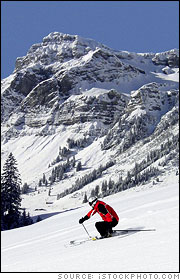2010 Olympics: Alpine Skiing


Vonn and Miller skiing toward the podium
by John Gettings and Christine Frantz
 Related Links
Memorable Moments |
Before it was a sport, skiing was an important means of transportation.
The exact origin of skiing is unclear, but there is evidence that Scandinavians were using skis to travel and hunt over snow-covered terrain as far back as 4,000 years ago.
Organized slalom races were first introduced in Europe during the 1920s and the first world championship was organized in 1931. Shortly thereafter, Americans caught on and interest in this country snowballed throughout the 1930s.
Alpine skiing made its Olympic debut at the 1936 Garmisch-Partenkirchen Games with a men's and women's combined event, featuring a downhill and two slalom runs. Giant slalom first appeared at the 1952 Oslo Games and the super giant slalom, or super G, was added at the 1988 Calgary Games.
Men and women will each compete in five Alpine skiing events at Vancouver:
- downhill: a steep descent against time
- slalom: a short race featuring sharp turns around flags
- giant slalom: longer, looser version of the slalom
- super G: slalom race that is a bit faster and longer than the giant slalom
- combined: one downhill run followed by two slalom runs; fastest combined time wins
All men's and women's alpine events will take place at Whistler Creekside, 120 km (84 mi) from Vancouver. The alpine events of the Games will begin with Men's downhill on Feb. 13, and end with Men's slalom on Feb. 27.
U.S. hopes are high this year with Lindsey Vonn, who boasts the most World Cup wins of any American woman, and the only American woman to win two World Cup overall titles. For the men, don't rule out 33-year-old veteran Bode Miller. With 31 World Cup wins, Miller is probably competing in his last Olympics, and he is keen to take a medal with him.
It's no coincidence that Western European countries at the foot of the Alps have dominated this sport—particularly Austria, which has won 101 medals, including 30 gold.
